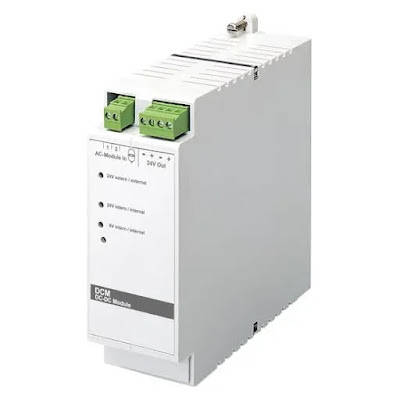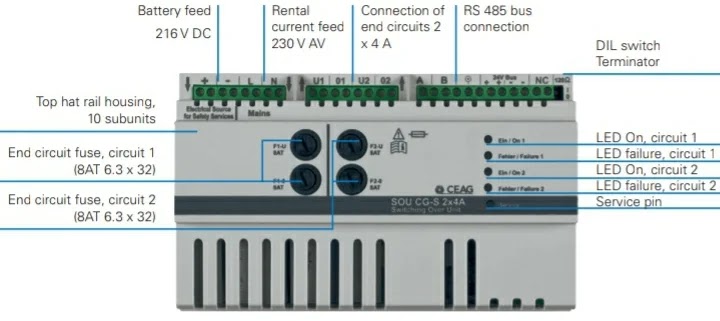Central battery system
CBS system is used in administrative, educational and commercial buildings, hospitals and other important and high-rise buildingsThe main purpose for using this system is to feed the emergency luminaires and Exit signs in the building in the emergency state
Components of central battery system
1) main distribution and control panel
Main control module is considered the thinking mind of the whole system ,it contains microprocessor circuits and controls all components of the system and monitors all emergency lighting units connected to the system .
- the batteries are usually lead acid or nickel cadmium type and are connected in series to produce the required voltage (usually 220V dc)
- The batteries capacity is selected so that it can be sufficient to feed or illuminate the emergency luminaires and escape signs for a period ranges from one hour to three hours .
- these are the modules responsible for feeding the connected lighting circuits and converting their feed from the normal source to the batteries
- the number of these modules is choosed depending on the number of the emergency lighting circuits required in the system and each module can feed one or two or four or more lighting circuits as needed and a maximum of 20 lighting units per circuit
- All outgoing circuits shall be protected with independent fuses
- The change over module communicates with main control module through its internal data bus
it converts the 220V dc voltage resulting from batteries to 24V and 6V dc to feed the main control module, circuit change over modules and all other modules
- it is used for charging the batteries with the required rated voltage and also controls the charging time of batteries
- The battery charger is controlled by the microprocessor of the main control module
- There is a DIP switch included in the battery charger for setting the maximum charging current according to the battery capacity
g) Load break switch for battery supply
it is a booster which is used when there is a need for full battery capacity
it is used in the battery part in CBS system so that in case of temperature rise than the allowable limits it gives alert to stop the charging or discharging process of the batteries .
2) Local Distribution board
The circuit change over module in the floor distribution board is fed with three cables :
First cable: two core cable (line+ neutral) coming from a power distribution panel located in the same floor and this cable feeds the panel and modules with 220V AC voltage
Second cable: it is a fire retardant DC cable ( + , -) coming from the main distribution and Control panel located in the ground floor and feeding the modules with 220V dc voltage
The third cable : it is a data cable (RS 485) also comes from the main distribution and control panel and its function is to monitor the status of all emergency luminaires and escape signs if they are working or not installed in place or not etc.
- The number of lighting circuits that you feed and control: for example, if we find that the unit converts circuits written on it (a 3*2) means that the unit feeds two lighting circuits and the load of each circuit must not exceed 3 amperes .
- Switching time from normal source to battery switching time: e.g. 450 milliseconds .
Important notes
- The floor distribution panel may have its own batteries and therefore do not need a DC cable from the main control panel
- The emergency luminaires always have the ability to operate with both AC and DC voltage through the electronic ballast located inside the luminaire .
Principle of operation of central battery system
Types of central battery systems
1) Non maintained central battery system
In this type , the normal supply system is monitored using relays whose contacts are wired or connected in a series loop so that in the event of normal supply failure , the loop will be broken and a signal is sent to the central battery system which will activate all the emergency luminaires installed in the system .
2) maintained central battery system
In this type , in the event of healthy normal supply , all of emergency luminaires are illuminated
In the event of failure of normal supply , the emergency luminaires are illuminated and fed from the CBS system batteries .
3) maintained central battery system with conversion module
- it containes more than one lamp (may be 4 lamps) only one of them is illuminated in case of main supply failure and all of them are illuminated in event of main supply healthy condition .
- It contains conventional control gear and a conversion module .
In the event of mains failure, the relay contacts drops out disconnecting the lamp from the conventional control gear and connecting it to the inverter included in the conversion module allowing the the luminaire to operate as an emergency luminaire at reduced brightness (through only one lamp)
Advantages of Central battery system
- The central battery system enables all emergency lighting units to be centrally monitored .
- In cbs system , if some batteries of emergency luminaires are damaged , all the damaged batteries can be detected by the CBS system and therefore can be replaced at the same time , which saves time and effort
- BMS can integrate the central monitoring systems of the CBS system into a single interface
- A centralized battery system is less costly and more effective than an emergency lighting system that uses separate batteries











